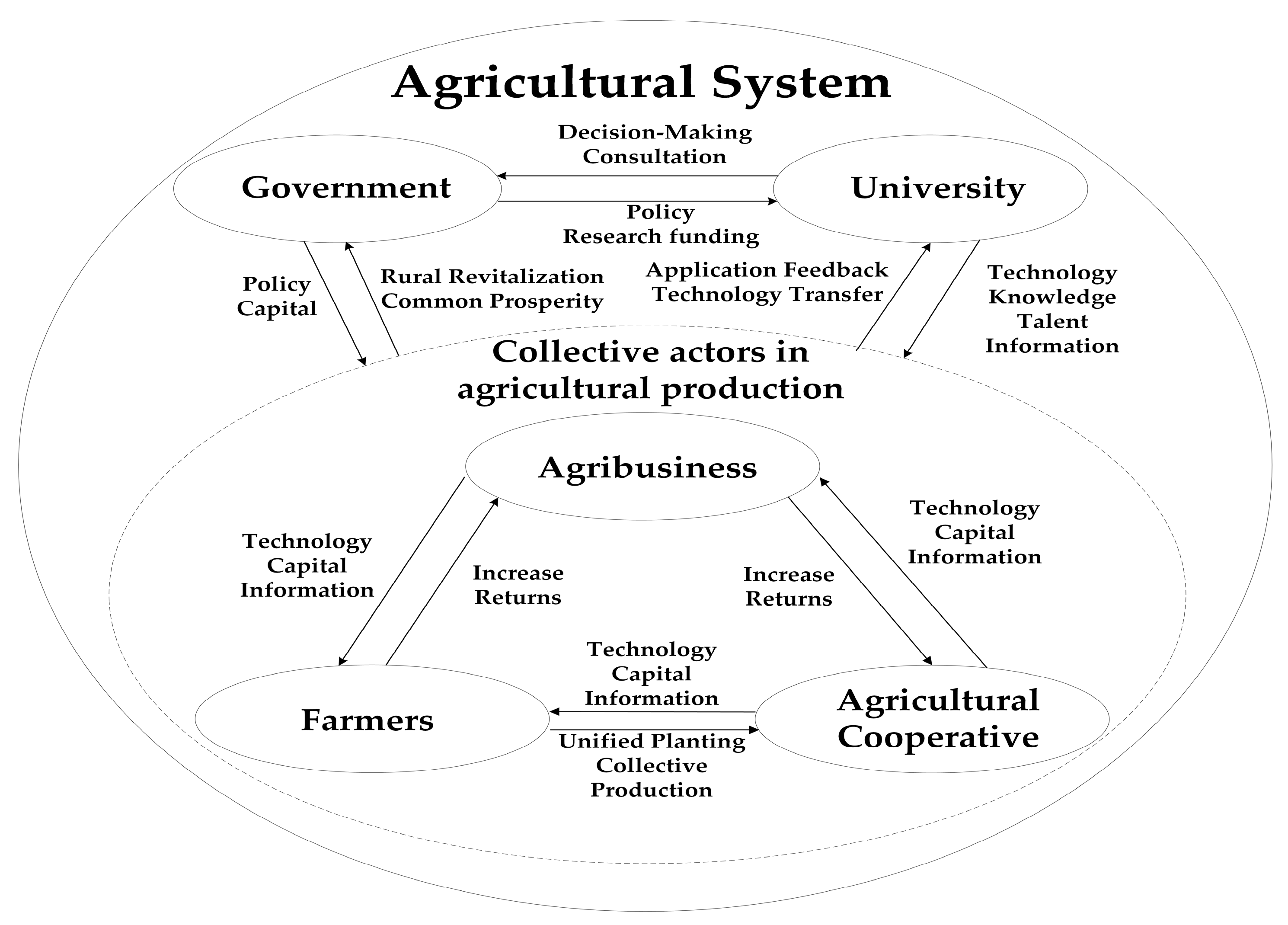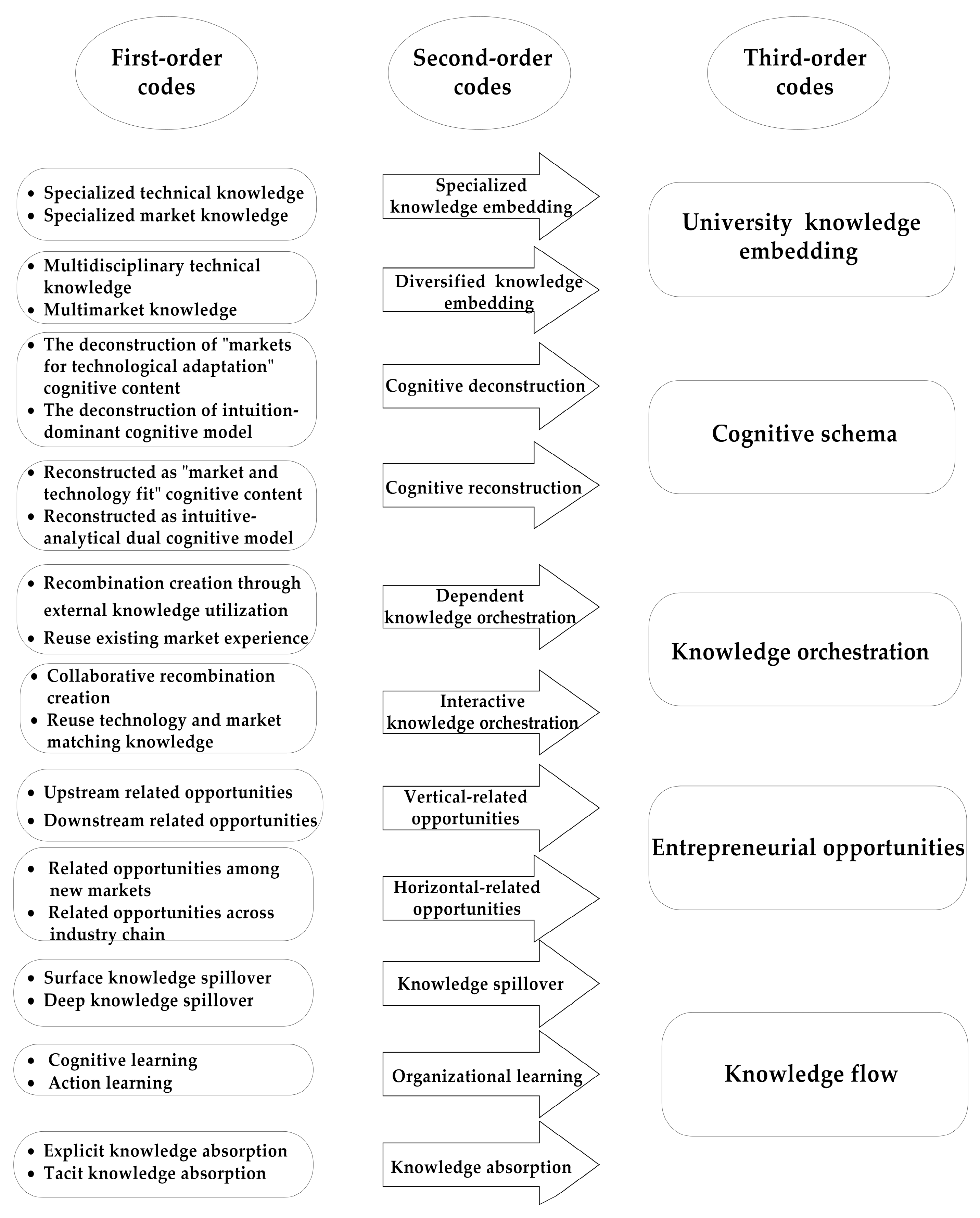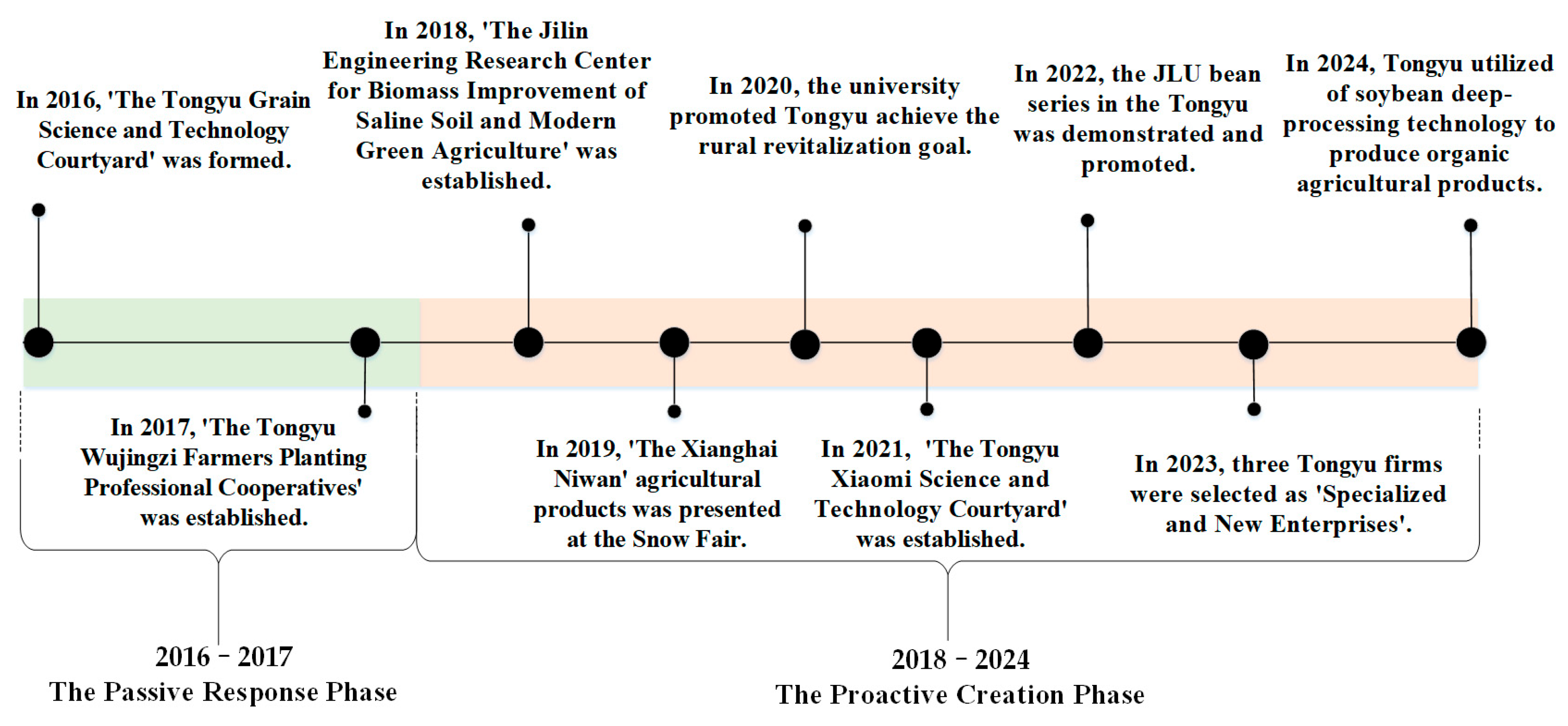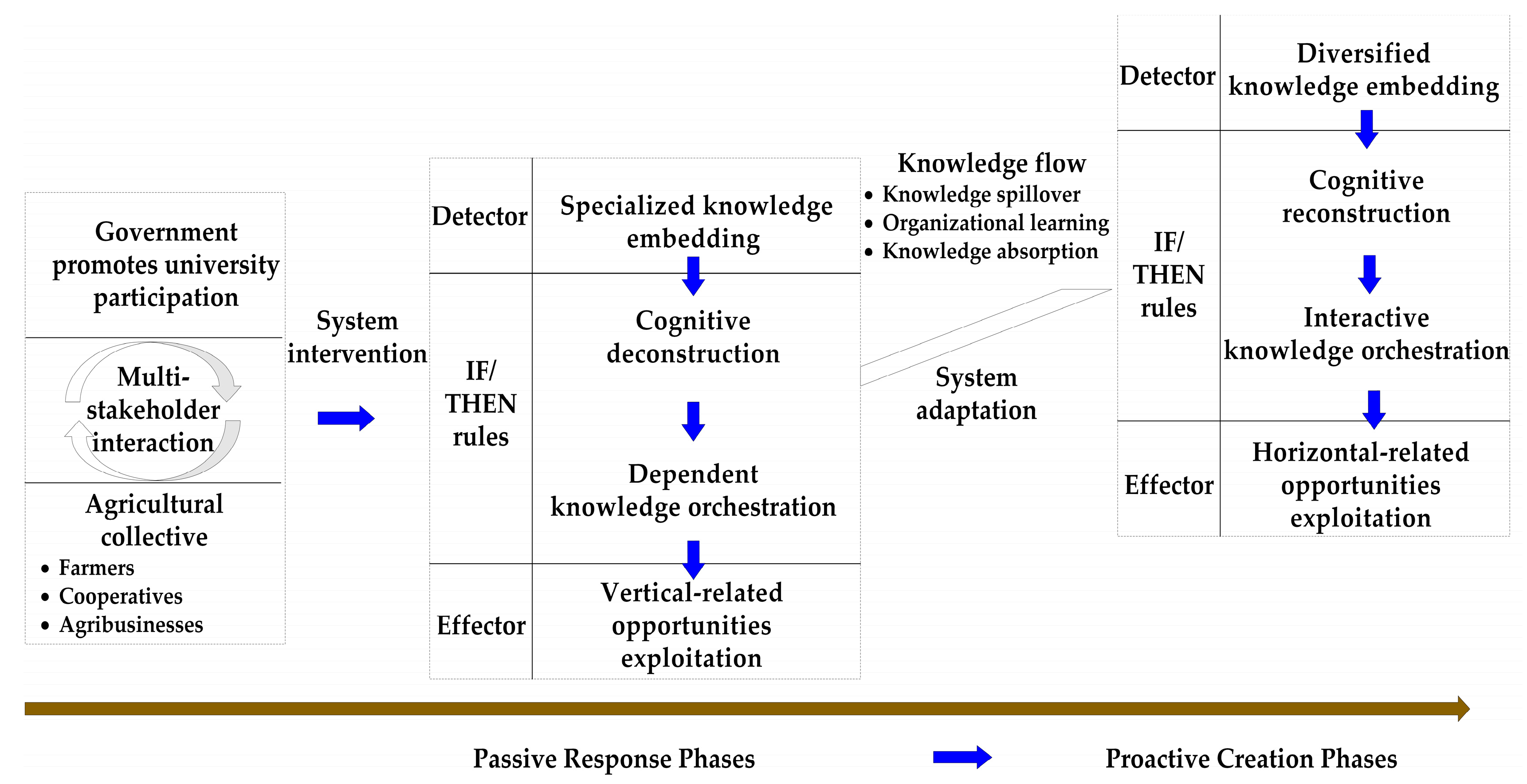From External Intervention to Endogenous Growth: A CAS-Based Analysis of Poverty Alleviation Mechanism with University Participation in Rural Collective Entrepreneurship
Abstract
1. Introduction
2. Literature Review and Analysis Framework
2.1. Entrepreneurship and Poverty Alleviation
2.2. University and Rural Development
2.3. Research Gaps
- (1)
- Detectors receive environmental stimuli, processing inputs to facilitate information perception;
- (2)
- IF/THEN rules regulate actors’ behavioral responses subsequent to information processing;
- (3)
- Effectors execute actions that alter actor states and environmental conditions.
3. Research Design
3.1. Case Selection: Tongyu County, Jilin Province, China
3.2. Research Methods and Data Collection
3.3. Data Coding Procedure
- (1)
- Identifiability: Employ transparent analytical procedures (including graphics) to ensure the identifiability of research conclusions.
- (2)
- Reliability: Guaranteed by standardized coding techniques and inter-coder consistency (>95%).
- (3)
- Trustworthiness: Enhanced by using three different types of data-interview data, archival records, and field observations-to make the research more valid.
- (4)
- Transferability: Contextual descriptions spanning temporal and geographical aspects provide a comparative framework and applicability for similar rural settings.
4. Case Analysis
4.1. The Passive Response Phase
4.1.1. Detectors: Specialized Knowledge Embedding
- (1)
- Zero-distance contact (technicians permanently stationed at agricultural production sites);
- (2)
- Zero-threshold access (unrestricted access to services);
- (3)
- Zero delayed responsiveness (real-time problem solving);
- (4)
- Zero-cost delivery (full-service delivery provided at no cost).
4.1.2. IF/THEN Rules: Cognitive Deconstruction-Dependent Knowledge Orchestration
4.1.3. Effectors: Vertical-Related Opportunities Exploitation
4.2. The Proactive Creation Phase
4.2.1. Detectors: Diversified Knowledge Embedding
4.2.2. IF/THEN Rules: Cognitive Reconstruction-Interactive Knowledge Orchestration
4.2.3. Effectors: Horizontal-Related Opportunities Exploitation
4.3. Cross- Phase Evolution Mechanism
4.3.1. Surface Knowledge Spillover-Cognitive Learning-Explicit Knowledge Absorption
4.3.2. Deep Knowledge Spillover-Action Learning-Tacit Knowledge Absorption
5. Discussion
5.1. The Poverty Alleviation Mechanisms with University Participation in Rural Collective Entrepreneurship
5.2. Knowledge as a Core Resource Throughout the Collective Entrepreneurship Pathway Model for Poverty Alleviation
6. Conclusions
6.1. Research Conclusion
6.2. Contribution
6.3. Management Implication
6.4. Limitation and Future Direction
Author Contributions
Funding
Data Availability Statement
Conflicts of Interest
References
- Fischer, K.; Johnson, E.; Visser, V.; Shackleton, S. Social drivers and differentiated effects of deagrarianisation: A longitudinal study of smallholder farming in South Africa’s Eastern Cape province. J. Rural Stud. 2024, 106, 103200. [Google Scholar] [CrossRef]
- Castellanza, L. Discipline, abjection, and poverty alleviation through entrepreneurship: A constitutive perspective. J. Bus. Ventur. 2022, 37, 106032. [Google Scholar] [CrossRef]
- Sutter, C.; Bruton, G.D.; Chen, J. Entrepreneurship as a solution to extreme poverty: A review and future research directions. J. Bus. Ventur. 2019, 34, 197–214. [Google Scholar] [CrossRef]
- Morris, M.H.; Santos, S.C.; Neumeyer, X. Entrepreneurship as a solution to poverty in developed economies. Bus. Horiz. 2020, 63, 377–390. [Google Scholar] [CrossRef]
- Wang, Y.; Li, B.; Niu, X.; Li, B. Return-to-hometown entrepreneurship and employment of low-income households: Evidence from national returned entrepreneurial enterprise data of China. Econ. Anal. Policy 2024, 84, 1714–1729. [Google Scholar] [CrossRef]
- Dias, A.; Selan, B. How does university-industry collaboration relate to research resources and technical-scientific activities? An analysis at the laboratory level. J. Technol. Transf. 2023, 48, 392–415. [Google Scholar] [CrossRef]
- Miller, D.J.; Acs, Z.J. The campus as entrepreneurial ecosystem: The University of Chicago. Small Bus. Econ. 2017, 49, 75–95. [Google Scholar] [CrossRef]
- Kitagawa, F.; Marzocchi, C.; Sanchez-Barrioluengo, M.; Uyarra, E. Anchoring talent to regions: The role of universities in graduate retention through employment and entrepreneurship. Reg. Stud. 2022, 56, 1001–1014. [Google Scholar] [CrossRef]
- Chen, J.; Rong, S.; Song, M. Poverty vulnerability and poverty causes in rural China. Soc. Indic. Res. 2021, 153, 65–91. [Google Scholar] [CrossRef]
- Jackson, T.M.; Nandi, R.; Jannat, A.; Ghosh, A.; Hajra, D.K.; Mitra, B.; Rashid, M.M.; Bista, S.; Chaudhary, A.; Timsina, P.; et al. Patterns of livelihood diversification in farming systems of the Eastern Gangetic Plains. Agric. Syst. 2025, 227, 104346. [Google Scholar] [CrossRef]
- Koster, S.; Brouwer, A.E.; van Leeuwen, E.S. Diversity as the key to success? Urban and rural employment dynamics in the Netherlands. Reg. Stud. 2020, 54, 1187–1199. [Google Scholar] [CrossRef]
- Miles, M.P.; Morrison, M. An effectual leadership perspective for developing rural entrepreneurial ecosystems. Small Bus. Econ. 2020, 54, 933–949. [Google Scholar] [CrossRef]
- Borgen, S.O.; Aarset, B. Participatory innovation: Lessons from breeding cooperatives. Agric. Syst. 2016, 145, 99–105. [Google Scholar] [CrossRef]
- Tittonell, P. Assessing resilience and adaptability in agroecological transitions. Agric. Syst. 2020, 184, 102862. [Google Scholar] [CrossRef]
- Gaddefors, J.; Korsgaard, S.; Ingstrup, M.B. Regional development through entrepreneurial exaptation: Epistemological displacement, affordances, and collective agency in rural regions. J. Rural Stud. 2020, 74, 244–256. [Google Scholar] [CrossRef]
- Robert, F.C.; Frey, L.M.; Sisodia, G.S. Village development framework through self-help-group entrepreneurship, microcredit, and anchor customers in solar microgrids for cooperative sustainable rural societies. J. Rural Stud. 2021, 88, 432–440. [Google Scholar] [CrossRef]
- Simba, A.; Wang, Y.; Garcia, F.d.O. Deconstructing self-organisation in microentrepreneurship: A social embeddedness perspective. J. Bus. Res. 2023, 162, 113916. [Google Scholar] [CrossRef]
- Song, Y.; Gong, Y.; Song, Y.; Chen, X. Exploring the impact of digital inclusive finance on consumption volatility: Insights from household entrepreneurship and income volatility. Technol. Forecast. Soc. Change 2024, 200, 123179. [Google Scholar] [CrossRef]
- Trivedi, S.K.; Petkova, A.P.; Willems, J. Building social capital to escape poverty: An intersectionality perspective on women’s entrepreneurship at the base of the pyramid. Entrep. Reg. Dev. 2025, 1–28. [Google Scholar] [CrossRef]
- Lin, H.; Li, Y.; Zhou, L. A Consociation Model: Organization of Collective Entrepreneurship for Village Revitalization. Systems 2022, 10, 127. [Google Scholar] [CrossRef]
- Shane, S.; Venkataraman, S. The promise of entrepreneurship as a field of research. Acad. Manag. Rev. 2000, 25, 217–226. [Google Scholar] [CrossRef]
- Chamberlain, W.; Anseeuw, W. Inclusive businesses in agriculture: Defining the concept and its complex an evolving partnership structures in the field. Land Use Policy 2019, 83, 308–322. [Google Scholar] [CrossRef]
- Arocena, R.; Sutz, J. Universities and social innovation for global sustainable development as seen from the south. Technol. Forecast. Soc. Change 2021, 162, 120399. [Google Scholar] [CrossRef]
- Goddard, J.; Coombes, M.; Kempton, L.; Vallance, P. Universities as anchor institutions in cities in a turbulent funding environment: Vulnerable institutions and vulnerable places in England. Camb. J. Reg. Econ. Soc. 2014, 7, 307–325. [Google Scholar] [CrossRef]
- Veugelers, R. The embodiment of knowledge: Universities as engines of growth. Oxf. Rev. Econ. Policy 2016, 32, 615–631. [Google Scholar] [CrossRef]
- Loi, M.; Di Guardo, M.C. The third mission of universities: An investigation of the espoused values. Sci. Public Policy 2015, 42, 855–870. [Google Scholar] [CrossRef]
- Compagnucci, L.; Spigarelli, F. The third mission of the university: A systematic literature review on potentials and constraints. Technol. Forecast. Soc. Change 2020, 161, 120284. [Google Scholar] [CrossRef]
- Yin, X.; Chen, J.; Li, J. Rural innovation system: Revitalize the countryside for a sustainable development. J. Rural Stud. 2022, 93, 471–478. [Google Scholar] [CrossRef]
- Shearmur, R.; Doloreux, D. The geography of knowledge revisited: Geographies of KIBS use by a new rural industry. Reg. Stud. 2021, 55, 495–507. [Google Scholar] [CrossRef]
- Charles, D. The rural university campus and support for rural innovation. Sci. Public Policy 2016, 43, 763–773. [Google Scholar] [CrossRef]
- Sabrina, T.; Alessio, C.; Chiara, A.; Gigliola, P.; Concetta, F.; Federica, B.; Paolo, P. Civic universities and bottom-up approaches to boost local development of rural areas: The case of the University of Macerata. Agric. Food Econ. 2021, 9, 15. [Google Scholar] [CrossRef]
- Salomaa, M.; Charles, D.; Bosworth, G. Universities and innovation strategies in rural regions: The case of the greater Lincolnshire innovation programme (UK). Ind. High. Educ. 2023, 37, 67–79. [Google Scholar] [CrossRef]
- Habiyaremye, A. Knowledge exchange and innovation co-creation in living labs projects in South Africa. Innov. Dev. 2020, 10, 207–222. [Google Scholar] [CrossRef]
- Grillitsch, M.; Coenen, L.; Morgan, K. Directionality and subsidiarity: Sustainability challenges in regional development policy. Reg. Stud. 2025, 59, 2492171. [Google Scholar] [CrossRef]
- Mwantimwa, K.; Ndege, N. Transferring knowledge and innovations through village knowledge center in Tanzania: Approaches, impact and impediments. Vine J. Inf. Knowl. Manag. Syst. 2024, 54, 379–397. [Google Scholar] [CrossRef]
- He, S.; Zhang, Y. Reconceptualising the rural through planetary thinking: A field experiment of sustainable approaches to rural revitalisation in China. J. Rural Stud. 2022, 96, 42–52. [Google Scholar] [CrossRef]
- Magistretti, S.; Pham, C.T.A.; Dell’Era, C. The creative process of problem framing for innovation: An integrative review and research agenda. J. Prod. Innov. Manag. 2025, 42, 987–1018. [Google Scholar] [CrossRef]
- Lamprinopoulou, C.; Renwick, A.; Klerkx, L.; Hermans, F.; Roep, D. Application of an integrated systemic framework for analysing agricultural innovation systems and informing innovation policies: Comparing the Dutch and Scottish agrifood sectors. Agric. Syst. 2014, 129, 40–54. [Google Scholar] [CrossRef]
- Sullivan, S. Ag-tech, agroecology, and the politics of alternative farming futures: The challenges of bringing together diverse agricultural epistemologies. Agric. Hum. Values 2023, 40, 913–928. [Google Scholar] [CrossRef]
- Yiyu, L.; Dongping, F. Reconstruction of the Systems Paradigm: A Study of Green Development in China from the Perspective of Process Philosophy. Syst. Res. Behav. Sci. 2017, 34, 585–593. [Google Scholar] [CrossRef]
- Qiao, Y.; Yan, M.; Liu, G.; Sarfo, I.; Qiao, J. Determinants and grassroots voices for specialized village development in China: A survey of 1155 village cadres. J. Rural Stud. 2025, 120, 103822. [Google Scholar] [CrossRef]
- Holmen, M.; Sanchez-Preciado, D.J.; Ljungberg, D. How does technology transfer evolve in rural regions? Transferors, recipients, and the role of absorptive capacity in developing economies. J. Rural Stud. 2025, 118, 103688. [Google Scholar] [CrossRef]
- Turner, J.A.; Klerkx, L.; Rijswijk, K.; Williams, T.; Barnard, T. Systemic problems affecting co-innovation in the New Zealand Agricultural Innovation System: Identification of blocking mechanisms and underlying institutional logics. Njas-Wagening. J. Life Sci. 2016, 76, 99–112. [Google Scholar] [CrossRef]
- Bravaglieri, S.; Aberg, H.E.; Bertuca, A.; de Luca, C. Multi-actor rural innovation ecosystems: Definition, dynamics, and spatial relations. J. Rural Stud. 2025, 114, 103492. [Google Scholar] [CrossRef]
- Wang, Y.; Huang, C.; Ye, X.; Zhang, J. Linkage and coordination: Industrial digital transformation from the perspective of innovation ecosystem. Technovation 2025, 144, 103228. [Google Scholar] [CrossRef]
- Pigford, A.-A.E.; Hickey, G.M.; Klerkx, L. Beyond agricultural innovation systems? Exploring an agricultural innovation ecosystems approach for niche design and development in sustainability transitions. Agric. Syst. 2018, 164, 116–121. [Google Scholar] [CrossRef]
- Cui, L.; Chen, Y.; Wang, X.; Liu, S. Complexity Review of NIMBY Conflict: Characteristics, Mechanism and Evolution Simulation. Systems 2023, 11, 246. [Google Scholar] [CrossRef]
- Mungaray-Lagarda, A.; Osorio-Novela, G.; Ramirez-Angulo, N. Service-learning to foster microenterprise development in Mexico. High. Educ. Ski. Work-Based Learn. 2022, 12, 50–63. [Google Scholar] [CrossRef]
- Dou, Y.; Bicudo da Silva, R.F.; McCord, P.; Zaehringer, J.G.; Yang, H.; Furumo, P.R.; Zhang, J.; Cristobal Pizarro, J.; Liu, J. Understanding How Smallholders Integrated into Pericoupled and Telecoupled Systems. Sustainability 2020, 12, 1596. [Google Scholar] [CrossRef]
- Zang, Y.; Yang, Y.; Liu, Y. Understanding rural system with a social-ecological framework: Evaluating sustainability of rural evolution in Jiangsu province, South China. J. Rural Stud. 2021, 86, 171–180. [Google Scholar] [CrossRef]
- Wang, J.; Qu, L.; Li, Y.; Feng, W. Identifying the structure of rural regional system and implications for rural revitalization: A case study of Yanchi County in northern China. Land Use Policy 2023, 124, 106436. [Google Scholar] [CrossRef]
- Tong, J.; Li, Y.; Yang, Y. System Construction, Tourism Empowerment, and Community Participation: The Sustainable Way of Rural Tourism Development. Sustainability 2024, 16, 422. [Google Scholar] [CrossRef]
- van Rooyen, A.; Bjornlund, H.; Moyo, M.; Pittock, J.; Parry, K.; Mujeyi, A. Agroecology and circular food systems: Decoupling natural resource use from rural development in sub-Saharan Africa? Int. J. Water Resour. Dev. 2025, 41, 489–511. [Google Scholar] [CrossRef]
- Walrave, B.; Talmar, M.; Podoynitsyna, K.S.; Romme, A.G.L.; Verbong, G.P.J. A multi-level perspective on innovation ecosystems for path-breaking innovation. Technol. Forecast. Soc. Change 2018, 136, 103–113. [Google Scholar] [CrossRef]
- Huang, L.; Tan, J.; Xie, G.; Tian, Y. The driving pathways for the construction of rural e-commerce entrepreneurial ecosystem based on the TOE framework. Humanit. Soc. Sci. Commun. 2024, 11, 1–14. [Google Scholar] [CrossRef]
- Gioia, D.A.; Corley, K.G.; Hamilton, A.L. Seeking qualitative rigor in inductive research: Notes on the Gioia methodology. Organ. Res. Methods 2013, 16, 15–31. [Google Scholar] [CrossRef]
- Pratt, M.G.; Sonenshein, S.; Feldman, M.S. Moving beyond templates: A bricolage approach to conducting trustworthy qualitative research. Organ. Res. Methods 2022, 25, 211–238. [Google Scholar] [CrossRef]
- Sjodin, D.; Frishammar, J.; Thorgren, S. How individuals engage in the absorption of new external knowledge: A process model of absorptive capacity. J. Prod. Innov. Manag. 2019, 36, 356–380. [Google Scholar] [CrossRef]
- Surie, G. Creating the innovation ecosystem for renewable energy via social entrepreneurship: Insights from India. Technol. Forecast. Soc. Change 2017, 121, 184–195. [Google Scholar] [CrossRef]
- Casagrande, M.; Alletto, L.; Naudin, C.; Lenoir, A.; Siah, A.; Celette, F. Enhancing planned and associated biodiversity in French farming systems. Agron. Sustain. Dev. 2017, 37, 57. [Google Scholar] [CrossRef]
- Chiu, M.-L.; Chiao, C.; Lin, C.-N. The Mediating Role of Absorptive Capability Between the Effect of Organizational Internalization Through Social Media on Open Inbound Innovation. Inf. Syst. Front. 2024, 26, 301–318. [Google Scholar] [CrossRef]
- Gruber, M.; MacMillan, I.C.; Thompson, J.D. Escaping the prior knowledge corridor: What shapes the number and variety of market opportunities identified before market entry of technology start-ups? Organ. Sci. 2013, 24, 280–300. [Google Scholar] [CrossRef]
- Ortt, J.R.; Kamp, L.M. A technological innovation system framework to formulate niche introduction strategies for companies prior to large-scale diffusion. Technol. Forecast. Soc. Change 2022, 180, 121671. [Google Scholar] [CrossRef]
- Espinosa, A.; Martinez-Lozada, A.C. The Viable System Model to Support Sustainable Self-Governance in Communities: Learning from Case Studies. Syst. Pract. Action Res. 2025, 38, 14. [Google Scholar] [CrossRef]
- Adner, R.; Kapoor, R. Innovation ecosystems and the pace of substitution: Re-examining technology S-curves. Strateg. Manag. J. 2016, 37, 625–648. [Google Scholar] [CrossRef]
- Dai, Y.; Yang, Y.; Leng, M. A novel alternative energy trading mechanism for different users considering value-added service and price competition. Comput. Ind. Eng. 2022, 172, 108531. [Google Scholar] [CrossRef]
- Secundo, G.; Massaro, A.; Del Vecchio, P.; Garzoni, A. An Entrepreneurial University Ecosystem for Sustaining the Twin Transition Through a Complex Adaptive System Approach. IEEE Trans. Eng. Manag. 2024, 71, 10966–10983. [Google Scholar] [CrossRef]
- Priyadarshini, P.; Abhilash, P.C. Rethinking of higher education institutions as complex adaptive systems for enabling sustainability governance. J. Clean. Prod. 2022, 359, 132083. [Google Scholar] [CrossRef]
- Gong, Y.; Janssen, M. From policy implementation to business process management: Principles for creating flexibility and agility. Gov. Inf. Q. 2012, 29, S61–S71. [Google Scholar] [CrossRef]
- Li, B.; Teece, D.J.; Baskaran, A.; Chandran, V.G.R. Dynamic Knowledge Management: A dynamic capabilities approach to knowledge management. Technovation 2025, 147, 103316. [Google Scholar] [CrossRef]
- Trantopoulos, K.; von Krogh, G.; Wallin, M.W.; Woerter, M. External Knowledge and Information Technology: Implications for Process Innovation Performance. Mis Q. 2017, 41, 287–300. [Google Scholar] [CrossRef]
- Jacobs, P.T.; Habiyaremye, A.; Fakudze, B.; Ramoroka, K.; Jonas, S. Producing Knowledge to Raise Rural Living Standards: How Universities Connect with Resource-Poor Municipalities in South Africa. Eur. J. Dev. Res. 2019, 31, 881–901. [Google Scholar] [CrossRef]
- Wu, B.; Liu, L.; Carter, C.J. Bridging social capital as a resource for rural revitalisation in China? A survey of community connection of university students with home villages. J. Rural Stud. 2022, 93, 254–262. [Google Scholar] [CrossRef]
- Cordeiro, G.S.; Arvate, P.R.; Story, J.; Pongeluppe, L.S. Heroes or villains? Agribusiness leaders in the Amazon region. Acad. Manag. Discov. 2025, 11, 17–38. [Google Scholar] [CrossRef]
- Carayannis, E.G.; Rozakis, S.; Grigoroudis, E. Agri-science to agri-business: The technology transfer dimension. J. Technol. Transf. 2018, 43, 837–843. [Google Scholar] [CrossRef]
- Rivera, A.E.; Herrera, M.M.; Hernandez, M.d.P.M.P. A University Strategy for Knowledge Democratization in Cooperatives. Lat. Am. Bus. Rev. 2025, 26, 157–181. [Google Scholar] [CrossRef]
- Johnston, A.; Prokop, D. Peripherality and university collaboration: Evidence from rural SMEs in the UK. J. Rural Stud. 2021, 88, 298–306. [Google Scholar] [CrossRef]
- Liu, Y.; Xi, S.; Wei, J.; Li, X. Exploring interventions for improving rural digital governance performance: A simulation study of the data-driven institutional pressure transmission mechanism. Technol. Forecast. Soc. Change 2024, 208, 123695. [Google Scholar] [CrossRef]






| Research Contents | Research Method |
|---|---|
| Entrepreneurship can alleviate poverty through remediation (accessing key resources), reform (institutional change), revolutionary (changing the capitalist system and society) [3]. | Literature Review |
| Regional development through collective agency (entrepreneurial exaptation) in rural Sweden [15]. | Ethnographic |
| Social cooperation and Self-Help-Groups in rural regions stimulate entrepreneurship and economic development [16]. | Modeling Simulation |
| Collective entrepreneurship can alleviate poverty by helping poor individuals integrate into societies [2]. | Case Study |
| Microentrepreneurs in rural regions can promote cluster formation and economic development through collective entrepreneurial action in weak institutional environment [17]. | Case Study |
| Digital financial inclusion in rural regions reduces income volatility by promoting household entrepreneurial activities [18]. | Empirical Study |
| BOP entrepreneurs can build social capital to escape poverty [19]. | Case Study |
| Research Contents | Research Method |
|---|---|
| Smallholder systems as local integrated human-natural systems comprising smallholder actors [49]. | Case Study |
| The rural system is a coupled social-ecological system composed of a resources subsystem and actor system [50]. | Empirical Study |
| The rural innovation system is a complex open socio-economic ecosystem for rural revitalization and development [28]. | Qualitative Analysis |
| The rural system is an open system defined by distinct structures and functions that arise from the interaction between its natural environment, resource endowment, and other factors [51]. | Case Study |
| The construction of a system includes system arrangement (behavioral rules) and system structure (particular scope) [52]. | Empirical Study |
| The circular agricultural production system seeks to ensure the economic, environmental, and social sustainability of agriculture via efficient resource utilization throughout the value chain [53]. | Empirical Study |
| The agricultural innovation system is a collaborative network of actors and organizations that co-create agricultural innovations (products, processes) [54]. | Qualitative Analysis |
| A rural innovation ecosystem is a network of interdependent actors co-evolving through collaboration to achieve shared value propositions for rural development [44]. | Qualitative Analysis |
| A Rural Entrepreneurial Ecosystem refers to the synergistic network of actors and institutions that facilitates the discovery, evaluation, and exploitation of entrepreneurial opportunities [55]. | Qualitative Analysis |
| Data Type | Interview Information | Code | ||
|---|---|---|---|---|
| Primary Data | Interviews | University technical support staffs | 151 min | FT1; FT2; FT3 |
| Rural revitalization office Manager | 97 min | FT4 | ||
| Tongyu County farmers and firm managers | 84 min | FT5 | ||
| Video interviews | 137 min | FT6 | ||
| Official website | 23 articles | A1 | ||
| Secondary data | Books | 3 documents | A2 | |
| CNKI paper | 3 articles | A3 | ||
| Third-party mainstream media | 13 articles | A4 | ||
| Other materials (e.g., WeChat, small programs, etc.) | 17 articles | A5 | ||
| Total number of words | 64,035 words | |||
Disclaimer/Publisher’s Note: The statements, opinions and data contained in all publications are solely those of the individual author(s) and contributor(s) and not of MDPI and/or the editor(s). MDPI and/or the editor(s) disclaim responsibility for any injury to people or property resulting from any ideas, methods, instructions or products referred to in the content. |
© 2025 by the authors. Licensee MDPI, Basel, Switzerland. This article is an open access article distributed under the terms and conditions of the Creative Commons Attribution (CC BY) license (https://creativecommons.org/licenses/by/4.0/).
Share and Cite
Wang, Y.; Chen, Z.; Yu, H. From External Intervention to Endogenous Growth: A CAS-Based Analysis of Poverty Alleviation Mechanism with University Participation in Rural Collective Entrepreneurship. Systems 2025, 13, 1061. https://doi.org/10.3390/systems13121061
Wang Y, Chen Z, Yu H. From External Intervention to Endogenous Growth: A CAS-Based Analysis of Poverty Alleviation Mechanism with University Participation in Rural Collective Entrepreneurship. Systems. 2025; 13(12):1061. https://doi.org/10.3390/systems13121061
Chicago/Turabian StyleWang, Yongzheng, Ziying Chen, and Haijing Yu. 2025. "From External Intervention to Endogenous Growth: A CAS-Based Analysis of Poverty Alleviation Mechanism with University Participation in Rural Collective Entrepreneurship" Systems 13, no. 12: 1061. https://doi.org/10.3390/systems13121061
APA StyleWang, Y., Chen, Z., & Yu, H. (2025). From External Intervention to Endogenous Growth: A CAS-Based Analysis of Poverty Alleviation Mechanism with University Participation in Rural Collective Entrepreneurship. Systems, 13(12), 1061. https://doi.org/10.3390/systems13121061





